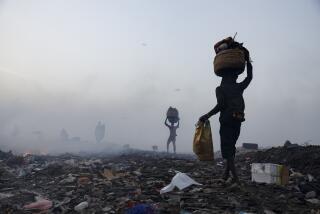Atmospheric Methane: Are Lakes, Wetlands the Culprits?
- Share via
BOULDER, Colo. — When Lesley K. Smith went for a hike in Rocky Mountain National Park a few years ago, she noticed bubbles rising from alpine ponds.
A limnologist--a biologist specializing in the study of inland waters--Smith said to herself: “I bet that’s methane.”
Colorless and odorless, methane is a flammable gas that rises into the atmosphere from numerous man-made and natural sources. With carbon dioxide, chlorofluorocarbons and other substances, it contributes to global warming.
The major human source of atmospheric methane is the burning of tropical forests and of fossil fuels--oil and coal. Nature sends it skyward from such uncontrollable sources as rice paddies, swamps, cattle and termites.
But lakes and their wetlands? They may be bigger culprits than previously suspected. Nobody had given them much thought until recently.
Smith’s observation of the ponds led to a 15-month study of five lakes in the Colorado Rockies. Little attention had been paid to northern lakes as methane producers.
As Smith and fellow scientist William M. Lewis Jr., both of the University of Colorado at Boulder, began their research, they didn’t expect dramatic discoveries.
Skiing onto lakes in winter to drill through the ice and take water samples from those not frozen solid, the researchers learned that methane sometimes builds up significantly under the ice.
Bacteria in the lake sediment feed on decaying organic material and release methane as a waste product. Methane diffuses into the water and sometimes bubbles to the surface or is oxidized in the oxygen-rich water. Winter ice traps pockets of methane.
“This is the first time someone has suggested that the spring thaw of lakes and the rapid release of methane may contribute to a seasonal increase in tropospheric methane,” said Smith, whose research is supported in part by the National Geographic Society.
“The data from the southern Rockies and information that has accumulated on other lake types over the last 15 years indicate that lakes may be a larger source of methane than reported estimates,” Smith and Lewis reported. It may account for 10% of atmospheric methane.
But more extensive research is necessary. The amount of methane and other gases in the atmosphere can be measured with reasonable accuracy, but pinpointing exact sources is another matter.
Smith said she would like to broaden her studies to lakes and wetlands in the Canadian Yukon, central Canada, Baffin Island and the upper Midwestern region of the United States.
Other experts disagree with the assumptions by Smith and Lewis. “Lakes probably do not contribute a large fraction of the total methane emissions,” said Pieter P. Tans, head of the climate monitoring and diagnostic laboratories of the National Oceanic and Atmospheric Administration in Boulder.
“Generally speaking, the amounts of methane coming from lakes are contributors (to the global greenhouse effect), but they’re not believed to be major contributors,” said F. Sherwood Rowland, a chemistry professor at UC Irvine.
Another expert, Inez Fung of the National Aeronautics and Space Administration, rated several sources by the megatons--millions of tons--they add to the atmosphere each year: Rice paddies contribute 100 megatons; animal emissions, 80; tropical wetlands, 80, and northern wetlands, 35.
Although not questioning those figures, Rowland said, “In general, the global knowledge of how much comes from each group is very weak.”
Scientists agree on one point: Atmospheric methane’s growth rate is slowing after nearly doubling since the early 1800s. But they don’t know why.
The rate now increases by about 1% a year. Some scientists predict that it will reach its global peak in 2006. The slowdown may be due partly to efforts to conserve energy, raising hopes for a related slowdown in the greenhouse effect.
During the 1980s, Rowland said, carbon dioxide caused about half of the increase in global warming. Methane caused another 20% to 25%. The rest came from other substances.
But unlike chlorofluorocarbons, which last for centuries, methane lasts only 10 years. The world’s atmosphere contains about 500 megatons of methane, Rowland said. If annual input could be reduced 10%, from 550 megatons to about 500, the atmospheric total would reach the break-even point.
“It’s an argument for more than a gasoline tax,” Rowland said. “It’s an argument for a carbon tax. We could do a lot if we could attain the same level of efficiency that West Germany and Japan have.” He acknowledges the political difficulties of such a tax.
Over the long haul, carbon dioxide poses a far greater threat than methane. Pieter Tans of NOAA puts it in perspective:
“Methane is a short-term problem compared to carbon dioxide. Carbon dioxide isn’t going to go away. The greenhouse effect is going to hang around.”





